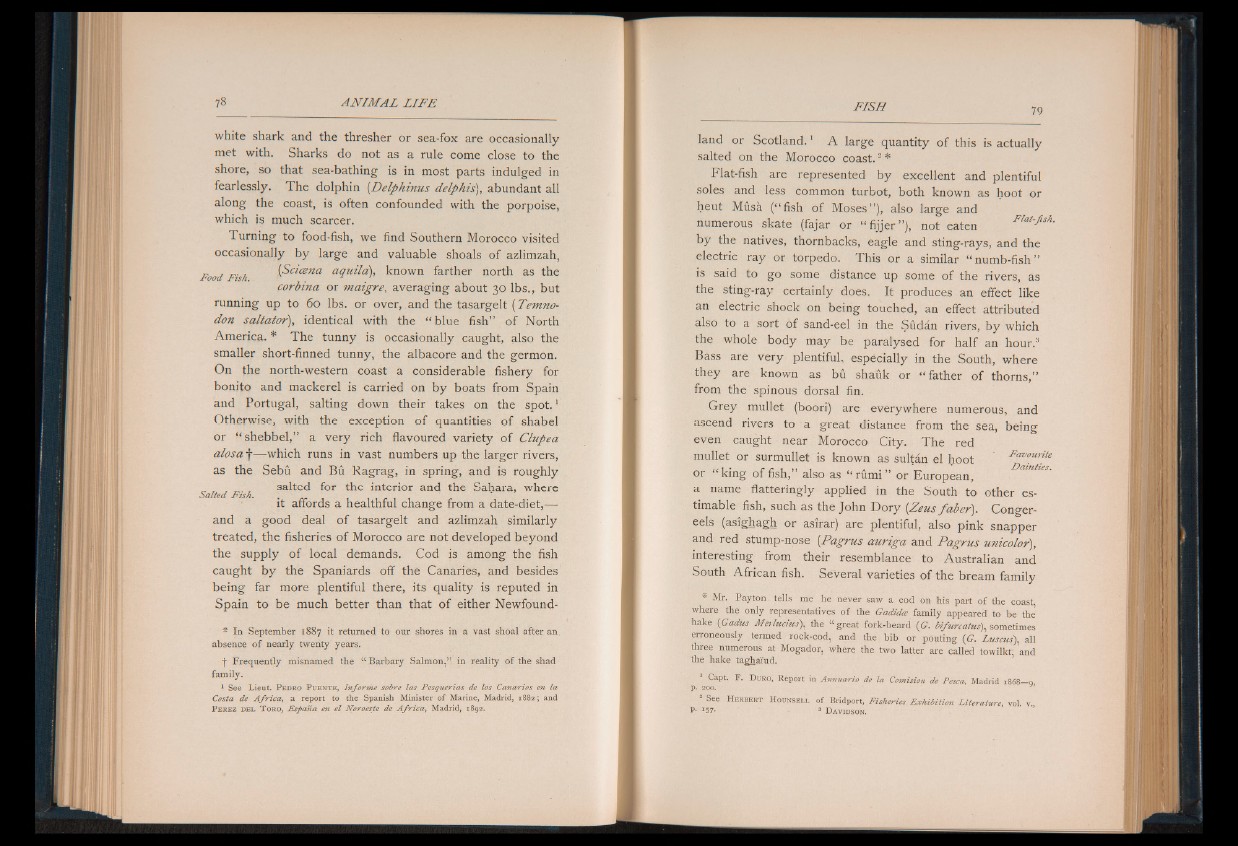
white shark and the thresher or sea-fox are occasionally
met with. Sharks do not as a rule come close to the
shore, so that sea-bathing is in most parts indulged in
fearlessly. The dolphin (Delphinus delpkis), abundant all
along the coast, is often confounded with the porpoise,
which is much scarcer.
Turning to food-fish, we find Southern Morocco visited
occasionally by large and valuable shoals of azlimzah,
Food Fish {Scicena aquilci), known farther north as the
corbina or maigre, averaging about 30 lbs., but
running up to 60 lbs. or over, and the tasargelt (Temnodon
saltator), identical with the “ blue fish” o f North
America. * The tunny is occasionally caught, also the
smaller short-finned tunny, the albacore and the germon.
On the north-western coast a considerable fishery for
bonito and mackerel is carried on by boats from Spain
and Portugal, salting down their takes on the spot.1
Otherwise, with the exception of quantities of shabel
or “ shebbel,” a very rich flavoured variety of Clupea
alosa f — which runs in vast numbers up the larger rivers,
as the Sebú and Bu Ragrag, in spring, and is roughly
„ , , _ , salted for the interior and the Sahara, where
Saltea Fish. .
it affords a healthful change from a date-diet,—
and a good deal o f tasargelt and azlimzah similarly
treated, the fisheries of Morocco are not developed beyond
the supply o f local demands. Cod is among the fish
caught by the Spaniards off the Canaries, and besides
being far more plentiful there, its quality is reputed in
Spain to be much better than that of either Newfound-
* In September 1887 it returned to our shores in a vast shoal after an.
absence of nearly twenty years.
f Frequently misnamed the “ Barbary Salmon,” in reality of the shad
family.
1 See Lieut. P edro P uente, Informe sobre las Pesquerías de los Canarios en la
Costa de A f r i c a a report to the Spanish Minister of Marine, Madrid, 1882; and
P erez del T oro, España en e l Noroeste de A fr ica , Madrid, 1892.
land or Scotland.1 A large quantity of this is actually
salted on the Morocco coast.2 *
Flat-fish are represented by excellent and plentiful
soles and less common turbot, both known as hoot or
heut Musa (“ fish of Moses” ), also large and
numerous skate (fajar or “ fijj.er” ), not eaten Fiat-fish.
by the natives, thornbacks, eagle and sting-rays, and the
electric ray or torpedo. This or a similar “ numb-fish”
is said to go some distance up some of the rivers, as
the sting-ray certainly does. It produces an effect like
an electric shock on being touched, an effect attributed
also to a sort of sand-eel in the Sudán rivers, by which
the whole body may be paralysed for half an hour.3
Bass are very plentiful, especially in the South, where
they are known as bu shauk or “ father of thorns,”
from the spinous dorsal fin.
Grey mullet (boori) are everywhere numerous, and
ascend rivers to a great distance from the sea, being
even caught near Morocco City. The red
mullet or surmullet is known as sultán el hoot Favounte
or “ king offish,” also as “ rurni” or European,
a name flatteringly applied in the South to other estimable
fish, such as the John Dory (Zeus faber). Conger-
eels (asighagh or asirar) are plentiful, also pink snapper
and red stump-nose (Pagrus auriga and Pagrus unicolor),
interesting from their resemblance to Australian and
South African fish. Several varieties of the bream family
* Mr. Payton tells me be never saw a cod on his part of the coast,
where the only representatives of the Gadidtz family appeared to be the
hake {Gadus MeiIndus'), the “ great fork-beard (G. bifurcatus), sometimes
erroneously termed rock-cod, and the bib or pouting (G. Luscus), all
three numerous at Mogador, where the two latter are called towilkt, and
the hake tagháiud.
1 CaPl - F - D uro, Report in Annuario de la Comisión de Pesca, Madrid 1868— 0,
P- 200.
2 See Herbert Hounsell o f Bridport, Fisheries. Exhibition Literature, vol. v.,
H ip l ! 3 Davidson.